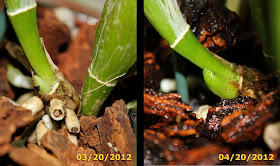A new batch of orchids arrived in the mail
The orchid show peaked my temptation to once again go orchid shopping. I made myself wait a couple of weeks, but when I saw a few of these plants go on sale, I ordered yet another batch of orchids for my collection. On the left is an in-spike Psychopsis Mariposa 'Mountain.' Meanwhile, on the right are two more tolumnias: Pink Panther and Genting Orange.
I intended to grow the tolumnias mounted, and the psychopsis had dead-looking roots poking out from the bottom of the pot. Consequently the first thing I did after taking this picture was soak the plants in water to loosen the roots for re-potting.
Frankly, the state of the psychopsis roots was disappointing. A number of the longest roots had grown right out of the pot, and I unfortunately had to cause some damage when pulling the plant out. Meanwhile, that soggy brown-looking thing in the middle of the picture (right at the base of the leaves) looks like ancient sphagnum moss.
I know psychopsis don't like being re-potted, but I am glad I did change the media immediately. The media was very old, and none of the roots looked very healthy. I trimmed back some of the mushy dead ones, and potted the orchid in a clear plastic pot with loosely packed fresh media.
Growing psychopsis spike
The orchid did sell 'in spike' at a very attractive discount, so I am hoping that it will be able to grow new roots and quickly establish itself in the new media. If not, I will nurse it until it recovers. Fortunately, my two oncidiums looked far worse and survived, and I expect to be able to save this orchid regardless of what happens in the next few months.
Tolumnia Pink Panther
Next I re-potted the two tolumnias. Tolumnia Pink Panther had the healthiest roots of the bunch. The root ball was about as big as the leaves themselves, and most of the roots were a healthy white/green color. To me this looked like an orchid ready for re-potting-- but not over-ready.
Tolumnia Genting Orange
Although it was in a smaller pot, Tolumnia Genting Orange had actually longer leaves than the Pink Panther (and slightly disappointingly, both were larger than my original Tolumnia Red Berry). Here, the orchid looks like it should have been re-potted a season ago. The healthy thicker roots were growing outside the pot. Meanwhile the mass of roots within the pot is a lackluster tan, and of dubious health.
However, I am now realizing that both these plants have far healthier roots than the Tolumnia Red Berry which I bought at the NYBG orchid show. Although that orchid hasn't lost any leaves yet, I am rather concerned about whether it now has any healthy roots at all.
Tolumnia growing spike
As a pleasant surprise I noticed that the Tolumnia Genting Orange was in spike as well (unlike the psychopsis, the plant was not listed as 'in-spike' on the online catalog). This means that if I get the care conditions right, I may have new orchids coming in to bloom when my Wilsonara Pacific Perspective finishes flowering.
Two orchids, one mount
I mounted both tolumnias on a log of 'aquarium decoration wood,' using some living moss and craft wire. The orientation of the top plant is not quite perfect (I would have liked it more vertical) but I figure the leaves will adjust over time.
With tolumnias I feel that the pots are so tiny, that I'd have to be watering them frequently anyway (my biggest concern with mounting orchids has been the necessity for daily watering). At least with the mounts, I'm less likely to rot the roots by accident. Meanwhile, since I can hang the mounts off the side of the shelf, I'm not taking away space from my other orchids. I love these cheery little orchids, and hope that I won't have casualties in my process of learning to grow them.



























